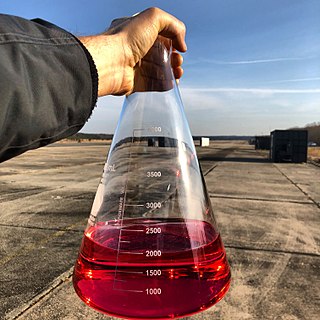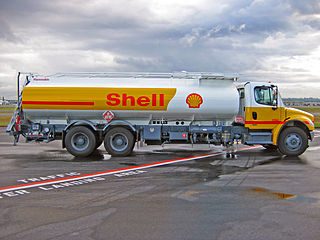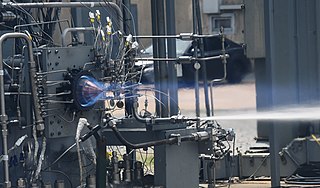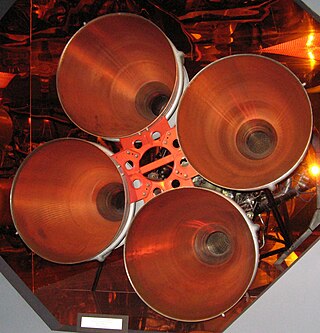Kerosene, or paraffin, is a combustible hydrocarbon liquid which is derived from petroleum. It is widely used as a fuel in aviation as well as households. Its name derives from Greek: κηρός (keros) meaning "wax", and was registered as a trademark by Canadian geologist and inventor Abraham Gesner in 1854 before evolving into a generic trademark. It is sometimes spelled kerosine in scientific and industrial usage.

JATO is a type of assisted take-off for helping overloaded aircraft into the air by providing additional thrust in the form of small rockets. The term JATO is used interchangeably with the term RATO, for rocket-assisted take-off.
A tripropellant rocket is a rocket that uses three propellants, as opposed to the more common bipropellant rocket or monopropellant rocket designs, which use two or one propellants, respectively. Tripropellant systems can be designed to have high specific impulse and have been investigated for single-stage-to-orbit designs. While tripropellant engines have been tested by Rocketdyne and Energomash, no tripropellant rocket has been flown.

Biofuel is a fuel that is produced over a short time span from biomass, rather than by the very slow natural processes involved in the formation of fossil fuels, such as oil. Biofuel can be produced from plants or from agricultural, domestic or industrial biowaste.

A rocket engine uses stored rocket propellants as the reaction mass for forming a high-speed propulsive jet of fluid, usually high-temperature gas. Rocket engines are reaction engines, producing thrust by ejecting mass rearward, in accordance with Newton's third law. Most rocket engines use the combustion of reactive chemicals to supply the necessary energy, but non-combusting forms such as cold gas thrusters and nuclear thermal rockets also exist. Vehicles propelled by rocket engines are commonly called rockets. Rocket vehicles carry their own oxidiser, unlike most combustion engines, so rocket engines can be used in a vacuum to propel spacecraft and ballistic missiles.

RP-1 (alternatively, Rocket Propellant-1 or Refined Petroleum-1) is a highly refined form of kerosene outwardly similar to jet fuel, used as rocket fuel. RP-1 provides a lower specific impulse than liquid hydrogen (LH2), but is cheaper, is stable at room temperature, and presents a lower explosion hazard. RP-1 is far denser than LH2, giving it a higher energy density (though its specific energy is lower). RP-1 also has a fraction of the toxicity and carcinogenic hazards of hydrazine, another room-temperature liquid fuel.

Aviation fuels are petroleum-based fuels, or petroleum and synthetic fuel blends, used to power aircraft. They have more stringent requirements than fuels used for ground use, such as heating and road transport, and contain additives to enhance or maintain properties important to fuel performance or handling. They are kerosene-based for gas turbine-powered aircraft. Piston-engined aircraft use leaded gasoline and those with diesel engines may use jet fuel (kerosene). By 2012, all aircraft operated by the U.S. Air Force had been certified to use a 50-50 blend of kerosene and synthetic fuel derived from coal or natural gas as a way of stabilizing the cost of fuel.

A jet pack, rocket belt, or rocket pack is a device worn on the back which uses jets of gas or liquid to propel the wearer through the air. The concept has been present in science fiction for almost a century and became widespread in the 1960s.
The highest specific impulse chemical rockets use liquid propellants. They can consist of a single chemical or a mix of two chemicals, called bipropellants. Bipropellants can further be divided into two categories; hypergolic propellants, which ignite when the fuel and oxidizer make contact, and non-hypergolic propellants which require an ignition source.

Jet fuel or aviation turbine fuel is a type of aviation fuel designed for use in aircraft powered by gas-turbine engines. It is colorless to straw-colored in appearance. The most commonly used fuels for commercial aviation are Jet A and Jet A-1, which are produced to a standardized international specification. The only other jet fuel commonly used in civilian turbine-engine powered aviation is Jet B, which is used for its enhanced cold-weather performance.

Camelina sativa is a flowering plant in the family Brassicaceae usually known as camelina, gold-of-pleasure, or false flax, but also occasionally as wild flax, linseed dodder, German sesame, or Siberian oilseed. It is native to Europe and areas of Central Asia, but cultivated as an oilseed crop mainly in Europe and in North America. It is not related to true flax, in the family Linaceae.

Romanian Cosmonautics and Aeronautics Association, also known as ARCAspace, is an aerospace company based in Râmnicu Vâlcea, Romania. It builds rockets, high-altitude balloons, and unmanned aerial vehicles. It was founded in 1999 as a non-governmental organization in Romania by the Romanian engineer and entrepreneur Dumitru Popescu and other rocket and aeronautics enthusiasts. Since then, ARCA has launched two stratospheric rockets and four large-scale stratospheric balloons including a cluster balloon. It was awarded two governmental contracts with the Romanian government and one contract with the European Space Agency. ARCASpace is currently developing a three-stage, semi-reusable steam-powered rocket called EcoRocket and in 2022 has shifted its business model to Asteroid mining.

The Armstrong Siddeley, later Bristol SiddeleyGamma was a family of rocket engines used in British rocketry, including the Black Knight and Black Arrow launch vehicles. They burned kerosene fuel and hydrogen peroxide. Their construction was based on a common combustion chamber design, used either singly or in clusters of up to eight.

Sustainable biofuel is biofuel produced in a sustainable manner. It is not based on petroleum or other fossil fuels. It includes not using plants that are used for food stuff to produce the fuel thus disrupting the world's food supply.

An aviation biofuel or bio-jet fuel or bio-aviation fuel (BAF) is a biofuel used to power aircraft and is said to be a sustainable aviation fuel (SAF). The International Air Transport Association (IATA) considers it a key element to reducing the carbon footprint within the environmental impact of aviation. Aviation biofuel could help decarbonize medium- and long-haul air travel generating most emissions, and could extend the life of older aircraft types by lowering their carbon footprint.

A fuel is any material that can be made to react with other substances so that it releases energy as thermal energy or to be used for work. The concept was originally applied solely to those materials capable of releasing chemical energy but has since also been applied to other sources of heat energy, such as nuclear energy.

Rocket propellant is the reaction mass of a rocket. This reaction mass is ejected at the highest achievable velocity from a rocket engine to produce thrust. The energy required can either come from the propellants themselves, as with a chemical rocket, or from an external source, as with ion engines.

A rotating detonation engine (RDE) is an engine using a form of pressure gain combustion, where one or more detonations continuously travel around an annular channel. Computational simulations and experimental results have shown that the RDE has potential in transport and other applications.

Soviet rocketry commenced in 1921 with development of Solid-fuel rockets, which resulted in the development of the Katyusha rocket launcher. Rocket scientists and engineers, particularly Valentin Glushko and Sergei Korolev, contributed to the development of Liquid-fuel rockets, which were first used for fighter aircraft and later for ballistic missiles, and space exploration. Progress was greatly augmented by the reverse engineering of Nazi German technology captured by westward-moving troops during the final days of World War II and the immediate period following, though after 1947 their influence was marginal. Developments continued in the 1950s with a variety of ICBMs and resulted in the launch of Sputnik 1 in 1957, the first artificial Earth satellite ever launched.
List of Aviation biofuel demonstration flights.
















